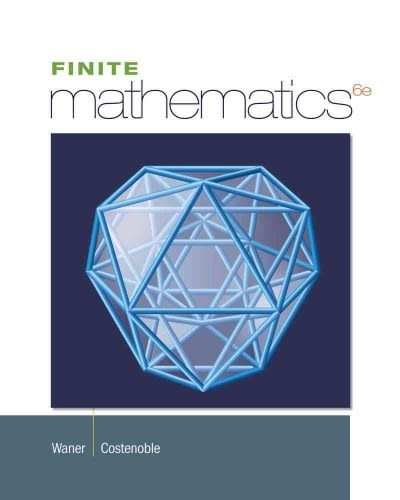Question
From generation to generation, the mean age when smokers first start to smoke varies. However, the standard deviation of that age remains constant at around
From generation to generation, the mean age when smokers first start to smoke varies. However, the standard deviation of that age remains constant at around 2.1 years. A survey of39smokers of this generation was done to see if the mean starting age is at least 19. The sample mean was18.1with a sample standard deviation of 1.3. Do the data support the claim at the 5% level?
Note: If you are using a Student'st-distribution for the problem, you may assume that the underlying population is normally distributed. (In general, you must first prove that assumption, though.)
- Part (a) Multiple choice
- State the null hypothesis.
a) H0:?= 19
b) H0:?19
c) H0:?<19
d) H0:?19
- Part (b) Multiple Choice
- State the alternative hypothesis.
a) Ha:?= 19
b) Ha:?19
c) Ha:?19
d) Ha:?<19
- Part (c) Multiple Choice
- In words, state what your random variableXrepresents.
a) Xrepresents the age of a person when he or she first began smoking.
b) Xrepresents the average age of the sample of smokers.
c) Xrepresents the average age when smokers first start to smoke.
d) Xrepresents the average number of cigarettes for each smoker.
- Part (d)
- State the distribution to use for the test. (Round your answers to four decimal places.)
- X~______(______,______)
- Part (e)
- What is the test statistic? (If using thezdistribution round your answers to two decimal places, and if using thetdistribution round your answers to three decimal places.)
- (z or t) =_______
- Part (f)
- What is thep-value? (Round your answer to four decimal places.)
- Explain what thep-value means for this problem.
a) IfH0is false, then there is a chance equal to thep-value that the average age of people when they first begin to smoke is 18.1 years or less.
b) IfH0is true, then there is a chance equal to thep-value that the average age of people when they first begin to smoke is 18.1 years or less.
c) IfH0is false, then there is a chance equal to thep-value that the average age of people when they first begin to smoke is not 18.1 years or less.
d) IfH0is true, then there is a chance equal to thep-value that the average age of people when they first begin to smoke is not 18.1 years or less.
- Part (g)
- Sketch a picture of this situation. Label and scale the horizontal axis and shade the region(s) corresponding to thep-value.
- Part (h)
- Indicate the correct decision ("reject" or "do not reject" the null hypothesis), the reason for it, and write an appropriate conclusion.
- (i) Alpha (Enter an exact number as an integer, fraction, or decimal.)
- ?=_____
- (ii) Decision:
a) reject the null hypothesis
b) do not reject the null hypothesis
- (iii) Reason for decision:
a) Since?>p-value, we do not reject the null hypothesis.
b) Since?<p-value, we do not reject the null hypothesis.
c) Since?>p-value, we reject the null hypothesis.
d) Since?<p-value, we reject the null hypothesis.
- (iv) Conclusion:
a) There is sufficient evidence to conclude that the starting age for smoking in this generation is less than 19.
b) There is not sufficient evidence to conclude that the starting age for smoking in this generation is less than 19.
- Part (i)
- Construct a 95% confidence interval for the true mean. Sketch the graph of the situation. Label the point estimate and the lower and upper bounds of the confidence interval. (Round your lower and upper bounds to two decimal places.)
Step by Step Solution
There are 3 Steps involved in it
Step: 1

Get Instant Access to Expert-Tailored Solutions
See step-by-step solutions with expert insights and AI powered tools for academic success
Step: 2

Step: 3

Ace Your Homework with AI
Get the answers you need in no time with our AI-driven, step-by-step assistance
Get Started


